Leroy Merlin, a leading home improvement and gardening retailer based in France, has established itself as a major force across Europe and beyond through a customer-focused and innovation-driven marketing strategy. Leroy Merlin stands out in the highly competitive DIY retail industry because of its extensive product range, value-driven pricing, and strong commitment to sustainability. This blog will analyze the key elements of the Leroy Merlin marketing strategy, highlighting the approaches and tactics that have propelled its growth and strengthened its connection with consumers.
The history of the leading European home improvement retailer, Leroy Merlin
Leroy Merlin, founded in 1923 in France by Adolphe Leroy and Rose Merlin, has grown into a leading international home improvement retailer with over 400 stores worldwide. Known for its wide product range, customer focus, and commitment to sustainability, the brand celebrated its 100th anniversary in 2023 with community and eco-friendly initiatives. While praised for innovation and green practices, it has faced criticism for continuing operations in Russia during recent geopolitical tensions. Despite this, Leroy Merlin remains a major force in the DIY retail sector across Europe and beyond.
The Leroy Merlin marketing strategy: Key metrics and charts
Leroy Merlin has solidified its position as one of the top-performing home improvement retailers in Europe, driven by strong international expansion, digital transformation, and a focus on sustainability and eco-responsible practices. Below are key business metrics highlighting its market strength:
| Global Revenue (2023) | €26 billion |
| Store Footprint | 400+ stores in 13+ countries |
| E-commerce Growth (2020–2023) | 40% growth |
| Employee Base | 100,000+ employees |
| Private Label Penetration | 50%+ of sales |
| Annual Customer Visits | 500 million+ visits/year |
| Market Position | #1 in France, Top 3 in Spain, Poland & Italy |
| Customer Satisfaction | High satisfaction ratings in annual surveys |
- Global revenue: Leroy Merlin generated an estimated €26 billion in revenue in 2023.
- Store footprint: Operates over 400 stores across 13+ countries, including France, Spain, Poland, and Brazil.
- E-commerce growth: Online sales grew by over 40% between 2020 and 2023, fueled by omnichannel investments.
- Employee base: Employs more than 100,000 people worldwide, fostering a decentralized, team-empowered culture.
- Private label penetration: Over 50% of products sold are Leroy Merlin private label, boosting margins and brand loyalty.
- Customer visits: Receives over 500 million annual store visits, with a growing share coming from mobile personalization.
- Market position: #1 DIY retailer in France, and top 3 in markets like Spain, Poland, and Italy.
- Customer Satisfaction: Consistently ranks high in customer service and in-store experience, according to annual surveys.
Decrypting Leroy Merlin’s business model: The key elements
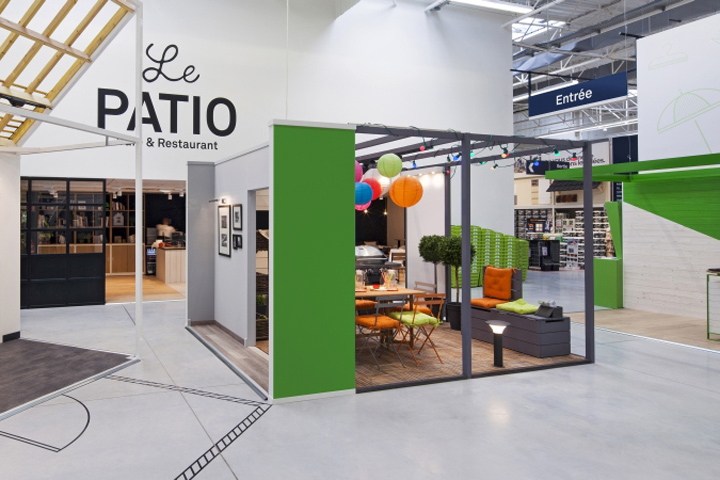
Leroy Merlin’s success stems from a well-balanced business model that combines product innovation, customer empowerment, and a deep commitment to sustainability. Below are the core elements that drive its continued growth and customer loyalty.
Element #1: Product variety and private label strategy
Leroy Merlin offers a vast and diverse product range across DIY, home improvement, and garden categories. A significant share of its inventory consists of high-quality private label products, which fosters brand loyalty by offering affordable and exclusive solutions tailored to local markets.
Element #2: Customer-Centric engagement
The brand emphasizes strong customer relationships through personalized in-store advice, DIY workshops, and responsive digital channels. Its loyalty programs and project support services help customers through every step of their renovation journey, reinforcing trust and repeat business.
Element #3: Commitment to sustainability and local impact
The Leroy Merlin marketing strategy invests heavily in sustainability, promoting energy-efficient products and eco-responsible practices. The brand also partners with local communities to support social and environmental initiatives, including job creation programs and green renovation projects.
Element #4: Immersive In-store and digital experience
Stores are designed to be spacious and inspirational, featuring product demonstrations, project zones, and helpful staff. With a rapidly evolving e-commerce platform and mobile app, Leroy Merlin creates a seamless omnichannel experience that empowers customers to plan, purchase, and build confidently.
Interesting articles to read:
- Leroy Merlin: A digital lick of paint for the in-store customer experience
- Leroy Merlin Enriches the Customer Experience With Hanshow Digital Solutions
- Campaign of the week / Leroy Merlin / Lessons for good
Digital marketing strategies of Leroy Merlin
The Leroy Merlin marketing strategy blends inspiration, education, and conversion across key digital channels. From engaging social media to localized emails and performance-driven ads, the brand delivers value at every touchpoint. Here’s how each channel supports customer engagement and growth.
Leroy Merlin’s social media strategy
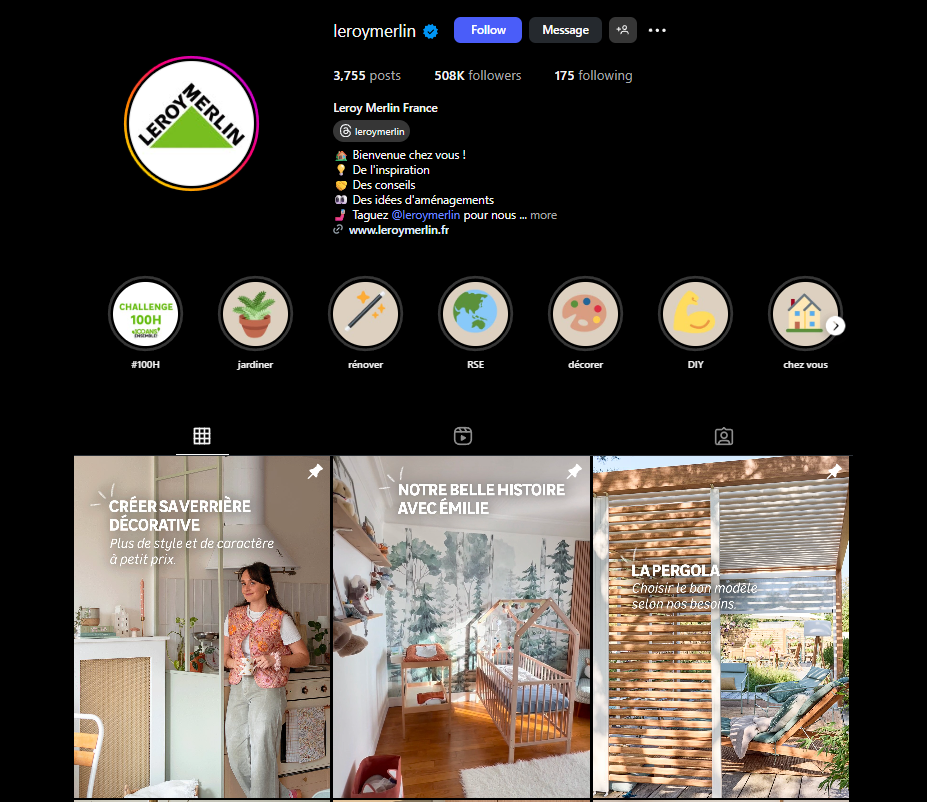
Leroy Merlin maintains an active and vibrant presence on platforms like Instagram, using visually engaging content, relatable hosts, and themed campaigns to connect with its audience. The brand’s social media content is not just promotional. It’s educational, community-focused, and designed to create an approachable and enjoyable brand image.
- Community-centered thematic campaigns: The Garden Days campaign runs as a seasonal, content-rich event. It includes influencer-hosted videos, gardening tips, live radio collaborations, and giveaways. This aligns with best practices in retail, where emotional storytelling and seasonal relevance enhance customer engagement and retention.
- Authentic, relatable brand ambassadors: Employees or brand ambassadors featured in the videos appear friendly, casual, and knowledgeable. This humanizes the brand and increases relatability, key to building trust and loyalty in modern retail marketing.
- Interactive and multi-format content: The Leroy Merlin marketing strategy utilizes a mix of reels, carousel posts, contests, and live broadcasts to keep content dynamic and engaging. The use of UGC-style visuals, humor, and direct calls to action (e.g., giveaways, must-haves, and beginner tips) aligns with advanced engagement strategies seen in top retail brands, encouraging active participation from followers.
Leroy Merlin’s email marketing strategy
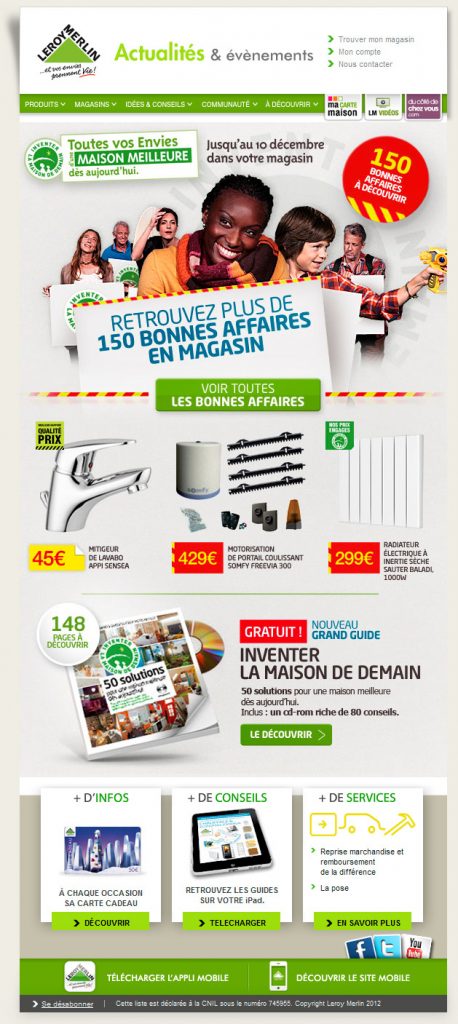
Leroy Merlin uses email marketing to promote offers, highlight product categories, and reinforce their customer-centric services. Their emails are visually engaging and structured to guide users toward in-store visits, online purchases, or utilizing services like delivery or DIY assistance.
- Strong use of personalization and localization: Leroy Merlin adapts emails to specific store locations (e.g., “Leroy Merlin Grande-Synthe – Dunkerque”) and includes local offers tailored to each location. Personal salutations like “Bonjour Fabien” or “Bonjour Prénom” show an intent to personalize content at the individual level.
- Clear, action-oriented design with multiple CTAs: Buttons like “Voir toutes les bonnes affaires”, “En savoir plus”, and “Télécharger” are prominent and guide users. Multiple CTAs in a single email target different user intents, product discovery, service usage, or guide downloads.
- Value-driven content and crisis responsiveness: During crises (e.g., COVID-19), their email, “Prenez soin de votre maison…”, offers empathetic messaging while presenting solutions such as “Retrait 2H”, “Livraison à domicile”, and “Dépannage”. It reinforces their brand promise: supporting customers’ home needs in all situations.
Leroy Merlin’s paid ads strategy
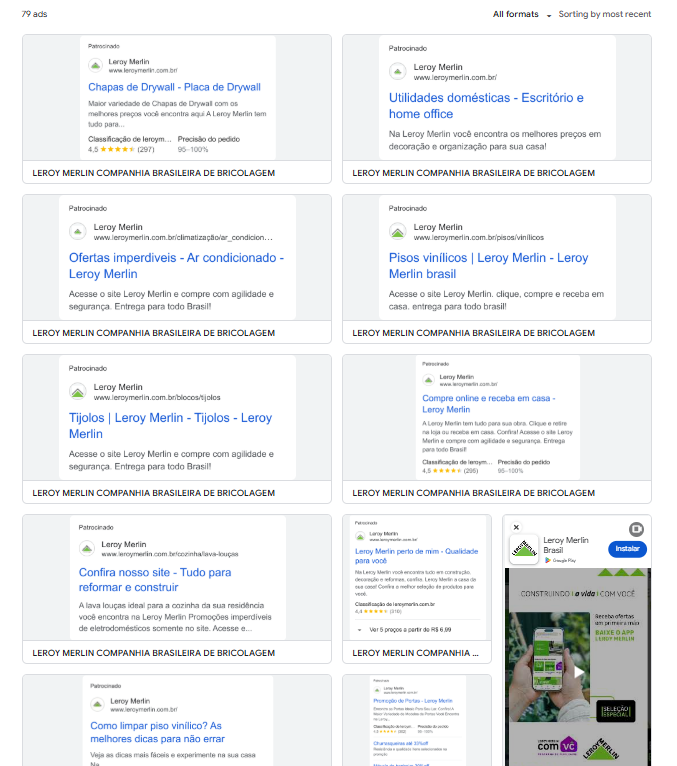
The Leroy Merlin marketing strategy adopts a performance-driven paid advertising approach that leverages search engine marketing (SEM) to target high-intent shoppers. Their approach is heavily oriented towards product-specific campaigns, focusing on utility, urgency, and convenience to capture customer interest at the moment of need.
- Hyper-specific product targeting with high purchase intent: Leroy Merlin uses precise ad copy tailored to specific home improvement products such as chapas de drywall, pisos vinílicos, and fechaduras digitais. This aligns with retail best practices that prioritize intent-based keyword targeting to drive conversions.
- Local and convenience messaging: Ads often include localized offers (e.g., “Campo Grande”) and convenience-driven CTAs, such as “Compre online e receba em casa” (Buy online and receive at home), capitalizing on the growing demand for e-commerce and regional fulfillment. This shows a strong understanding of omnichannel retail behavior.
- Consistent branding with broad category coverage: The brand maintains consistency across all ads, reinforcing trust and recall. Simultaneously, it covers a wide range of categories (construction, home office, kitchen, sanitation), ensuring comprehensive customer reach.
Leroy Merlin’s SEO strategy
Leroy Merlin’s SEO strategy reflects a well-coordinated effort to boost visibility through localized content, product-focused keywords, and cross-channel consistency. By aligning paid search, web structure, and thematic campaigns, the brand strengthens its presence across both organic and paid search landscapes. We analyzed Leroy Merlin’s SEO strategy for their category page, and we came up with some interesting findings.
| Keyword Usage in Headings | Page headers and section labels consistently reflect high-volume keywords relevant to home decor and furnishings. |
| Category Breadcrumbs | Breadcrumb trail supports navigational hierarchy and contextual relevance for both users and search engines. |
| Product Filters and Tags | Filters allow refinement by price, material, size—improving UX and crawl depth with unique parameterized URLs. |
| Product Titles and Descriptions | Product names are rich in attributes (e.g., brand, dimensions), improving discoverability in long-tail searches. |
| Mobile Optimization | Design is clean, responsive, and touch-optimized—likely boosting SEO under Google’s mobile-first indexing. |
| Image Alt Text | Images are likely tagged with descriptive alt text (e.g., product type, color), aiding accessibility and SEO. |
| Internal Linking | Cross-links to related subcategories enhance crawlability and spread link equity across key product pages. |
| Promotional Schema | Badges imply urgency or exclusivity and can be enhanced by offer schema for SEO-rich search results. |
| Content Personalization | Opening copy uses persuasive tone to connect with readers emotionally while maintaining keyword alignment. |
| Local Language Targeting | Full localization signals relevance to national searches and supports multilingual SEO strategy. |
| Page Load Speed | Images and page content appear optimized for fast load on mobile and desktop, minimizing bounce rate. |
| Metadata & Title Tag | Though not visible in screenshots, likely use of keyword-optimized title tag and meta description exists. |
| Structured Data / Schema | Offer elements, pricing, and availability suggest usage of Product/Offer schema for enhanced search display. |
| User Experience & Engagement | UX elements such as sticky CTAs, sectioned layout, and bold discount visuals encourage longer page time. |
| Chat & Feedback Widget | E-satisfaction feedback module boosts user trust and may signal quality/engagement to search engines. |
| Call-to-Action Buttons | Buttons are prominent and action-oriented, aiding conversion and behavioral SEO. |
- Keyword-rich, utility-oriented paid campaigns: Leroy Merlin’s Google Ads in Brazil are highly targeted around product-specific, high-intent keywords. These not only support performance marketing but also signal to search engines what product categories the brand is authoritative in.
- Localized and structured on-page elements: Pages like the kitchen category page and product listings use well-structured URLs, category names, and rich metadata with product descriptors, which are optimized in the local language. This enhances SEO relevance for regional markets and improves visibility for local searches.
- Content and conversion alignment: Email campaigns and social posts are keyword-aligned with broader content themes, helping reinforce seasonal and thematic SEO clusters.
Analysis of Leroy Merlin’s eCommerce strategy
Leroy Merlin demonstrates a strong foundation in digital retail, offering a robust omnichannel experience anchored in convenience, personalization, and project-oriented shopping. The following section breaks down performance across the homepage, category, product, and checkout pages, highlighting strengths and areas for improvement.
Home page analysis
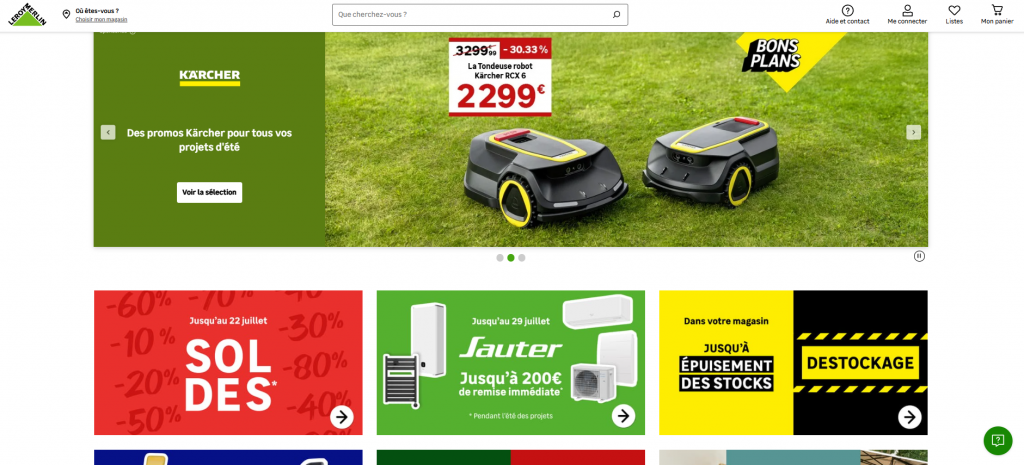
The homepage delivers high-impact seasonal promotions that grab attention quickly. However, the overwhelming visuals and lack of personalized product recommendations reduce overall engagement.
What we liked:
- Strong Visual Hierarchy: Hero banners for seasonal deals (e.g., robot mower promo) are prominent and eye-catching.
- Clear Value Proposition: Promotions like “SOLDES” (Sales) and “Bons Plans” (Good Deals) are emphasized.
- Category Diversity: Immediate access to a mix of categories (DIY, home comfort, clearance offers).
- Consistent Branding: Use of Leroy Merlin’s signature green and bold promotional colors enhances brand recall.
Areas to improve:
- Overcrowded Visuals: Multiple bold offers, discounts, and flashing colors create cognitive overload; users may feel overwhelmed.
- Poor Product Visibility: Above-the-fold space is almost entirely promotions; limited direct product discovery.
- Generic CTAs: Buttons like “Voir la sélection” (See selection) lack urgency or specificity; stronger action verbs recommended.
- Missed Personalization: No dynamic content based on location, purchase history, or recently browsed items, which is now standard for large retailers.
Category page analysis
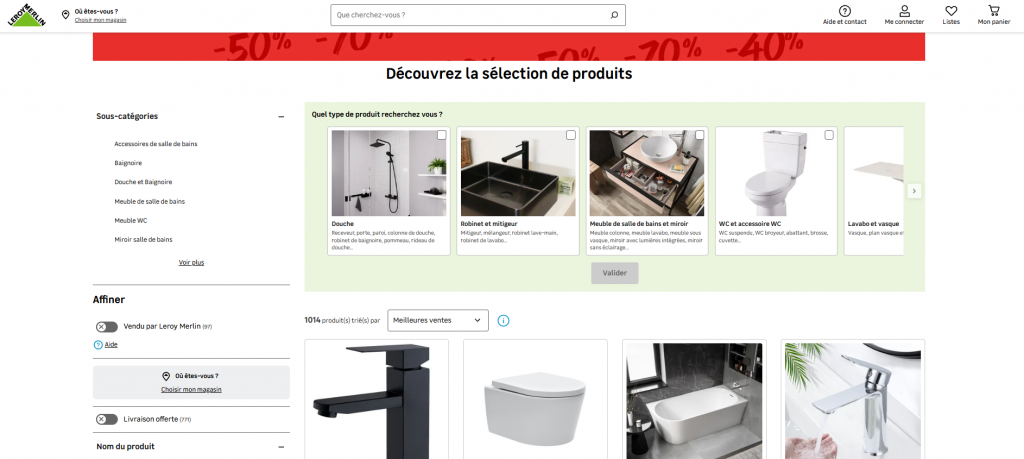
Product segmentation is clear, with visual filters making navigation easy for all user levels. Yet, the absence of trust signals, ratings, and inspirational lifestyle content limits the emotional connection with shoppers.
What we liked:
- Visual Product Filtering: Users can refine by product type with images (showers, sinks, furniture, etc.), an intuitive solution for non-technical shoppers.
- Subcategories Listed: Helps guide user journey efficiently without forcing deep menu navigation.
- Sorting Options Available: “Best sellers” default sorting aligns with eCommerce CRO trends.
- Product Thumbnails Are Clean: Clear, zoomable images boost product confidence pre-click.
Areas to improve:
- Flat, Text-Heavy Sidebar: Refinement filters like “Livraison offerte” (Free delivery) lack visual cues or urgency.
- No Immediate Promotions Displayed: Opportunity missed to highlight relevant discounts within the category view.
- Lack of Trust Signals: No star ratings or reviews visible directly on category thumbnails, common in high-performing marketplaces.
- Hidden Product Counts Per Filter: Showing how many items match each filter improves UX transparency.
Product page analysis
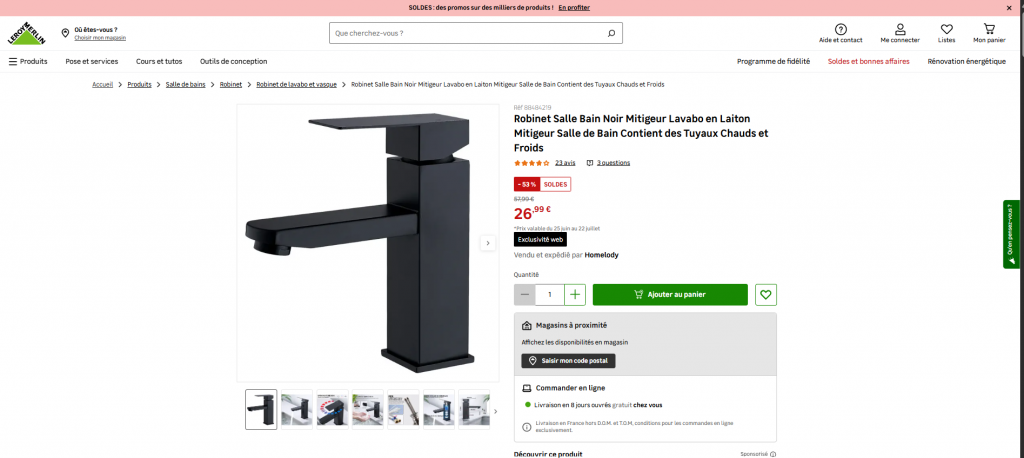
The checkout process is streamlined and transparent, with clear pricing and visual product confirmations. Nonetheless, missing urgency triggers, guest checkout prompts, and trust reinforcements could lead to avoidable cart abandonment.
What we liked:
- Price Anchoring Visible: Original price vs. sale price is clearly shown, including percentage saved.
- Web Exclusivity Label: Smart tactic to create FOMO (Fear of Missing Out) and drive online conversions.
- Star Ratings & Reviews: Essential social proof element present above the fold.
- Image Carousel: Allows detailed product inspection, improving buyer confidence.
- Stock and Delivery Info: Real-time shipping estimate boosts convenience perception.
Areas to improve:
- Weak Product Description: The title repeats technical jargon but lacks benefits-focused messaging (e.g., durability, design style).
- No Video Content: Increasingly expected, especially for home improvement products with design/installation factors.
- Limited Cross-Selling: No suggestions for complementary products like matching taps, valves, or bathroom sets.
- CTA Styling Is Basic: “Ajouter au panier” (Add to Cart) is clear but lacks contrast or animation to grab immediate attention.
Checkout page analysis
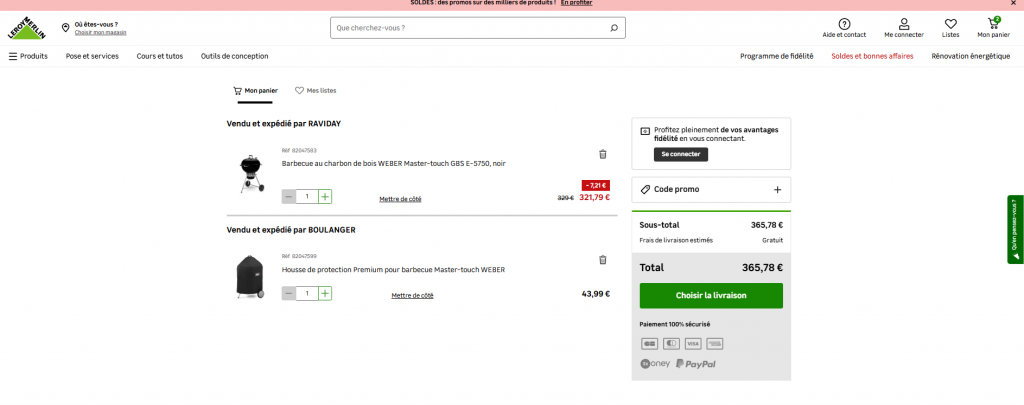
Checkout is user-friendly with clear CTAs, editable quantities, and transparent fulfillment options. However, the absence of a progress bar, full cost breakdown, and location confirmation may negatively impact conversion and perceived reliability.
What we liked:
- Minimal Friction: Clean layout, product images present, and price breakdown is clear.
- Cross-Sell Example: Barbecue and matching protective cover shown together increases AOV (Average Order Value).
- Total Cost Transparency: Full price, savings, and free delivery visibly outlined.
- Secure Payment Icons: Builds trust, especially for first-time customers.
Areas to improve:
- Guest Checkout Not Highlighted: Industry best practice is to promote guest checkout for new users to reduce abandonment.
- Loyalty Program Upsell Hidden: Small prompt to sign in for benefits is easily overlooked, and it should be bolder, preferably above cart summary.
- Missing Urgency: No shipping deadlines or countdown timers, which are proven to reduce cart abandonment.
- No Trust Badges Near CTA: Elements like “Satisfaction Guaranteed” or “Easy Returns” typically boost conversion rates.
How ContactPigeon’s retail CDP could assist Leroy Merlin
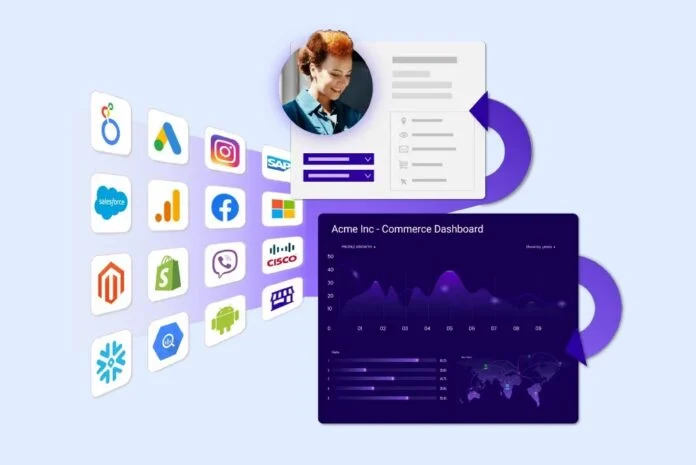
- Personalized product journeys: Leverage the CDP to build dynamic customer personas based on browsing behavior, home renovation interests (e.g., kitchens, bathrooms, garden), and past purchases. Automatically deliver tailored recommendations for bundles like cabinet fittings, lighting, or paint colors based on project type and complexity.
- Omnichannel synchronization: Connect online actions (site visits, abandoned carts, email clicks) with in-store data (purchases, location preferences) to launch omnichannel campaigns. For example, promote an in-store kitchen design event to customers who browsed cabinets online but didn’t convert.
- Dynamic segmentation: Segment customers by life stage (e.g., new homeowners, remodelers, renters) or project phase (planning, purchasing, renovating). Send ultra-targeted content like “Top 5 tiles for small kitchens” to planners or offer tool rental discounts to those in active renovation.
- Real-time insights: Utilize real-time analytics to identify trending categories (e.g., eco-friendly paints, modular kitchens) by region. Align store displays, inventory stocking, and local campaigns accordingly to meet demand before competitors react.
Lessons learned from the Leroy Merlin marketing strategy

- Build value through ecosystems: Leroy Merlin doesn’t just sell home improvement products; it enables full renovation journeys. By offering in-store kitchen designers, 3D project planning, and expert consultations, it positions itself as a project partner, not a mere retailer. Retailers should look beyond transactions and architect ecosystems around customer ambitions.
- Leverage store footprint as a value engine: Unlike many retailers shrinking their physical presence, Leroy Merlin turns its stores into omnichannel hubs, integrating click & collect, in-store returns, drive-in pickups, and on-site workshops. Its model proves stores can become fulfillment assets and community touchpoints, not overhead liabilities.
- Localize product strategy with data-driven merchandising: Leroy Merlin tailors inventory and promotional strategy at the regional level. Product availability, promotions, and in-store layouts often reflect seasonal needs and local housing trends. Retailers can learn to shift from a national strategy to hyperlocal execution, guided by customer data and behavior patterns.
- Turn utility into emotion: While hardware and home improvement products can be functional, Leroy Merlin excels in converting utility into aspiration. Lifestyle imagery, themed installations (e.g., “small kitchen hacks”), and seasonal campaigns transform nails, cabinets, and paint into dream projects. Emotional resonance can boost engagement, even in practical categories.
- Build loyalty through purpose: Rather than over-relying on discount-based loyalty programs, the Leroy Merlin marketing strategy fosters loyalty by empowering self-reliance and sustainable living. Its content, workshops, and CSR initiatives often focus on environmental responsibility and DIY skills development, creating alignment between brand purpose and customer values.
Interesting statistics about Leroy Merlin
- Founded in 1923, Leroy Merlin has expanded to operate nearly 400 stores across 12 countries, including France, Spain, Italy, Poland, and Brazil (Compworth).
- As of 2024, the company employs approximately 64,100 people worldwide (Compworth).
- In 2024, Leroy Merlin achieved a global revenue of $24.2 billion, reflecting its significant presence in the home improvement retail sector (Compworth).
- Leroy Merlin Greece collaborates with 1,950 local suppliers, contributing to a turnover of €47.52 million, underscoring its commitment to supporting the local economy (reporter.gr).
Final Thoughts on Leroy Merlin’s Marketing Strategy
Leroy Merlin’s marketing success lies in its ability to blend operational scale with human-centric experiences across digital and in-store touchpoints. By prioritizing personalization, sustainability, and customer empowerment, the brand stands out in the competitive DIY landscape. As it continues to grow, success will hinge on scaling these strengths across every market and channel. Want to achieve similar results? Book a free demo with a ContactPigeon expert to explore how our omnichannel solutions can power your marketing strategy.


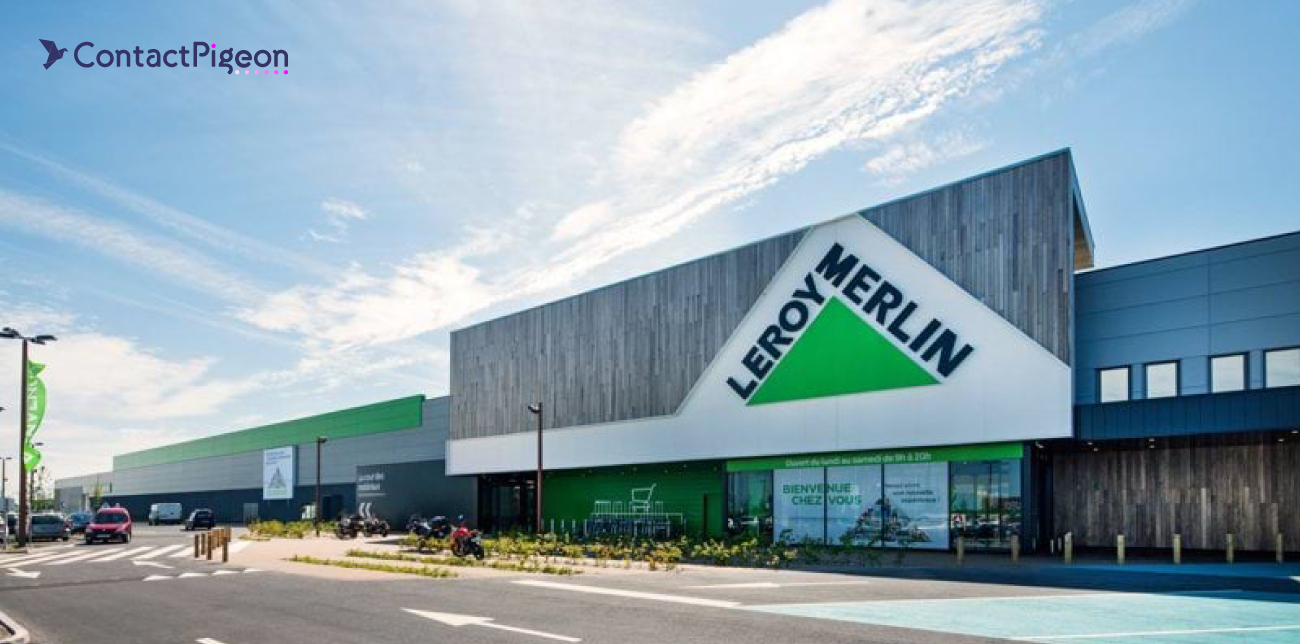

![Benchmarking Growth Strategies of Top Fashion Retailers [Study]](https://blog.contactpigeon.com/wp-content/uploads/2025/11/top-fashion-retailers.jpg)